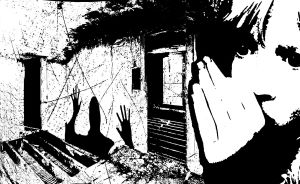This book comes with a prerequisite. "Prepare yourselves for a reading experience like no other," says Jim McLeod in the intro. Wise words, because the route this book takes is an elliptical one. It weaves its way through the dark, rat-infested alleyways of the sickest minds, leaving the smallest of clues in its wake. This is not a mystery collection, but it's certainly an enigma. I wouldn't class it as pure horror, though what drives it is horrific. Neither is it a thriller, though it has you on the edge of your seat. It is more like the product of an incestuous coupling of genres. Kelso gives us poetry, philosophy, ritual, mutilation, lustmord, comedy, an imagined conversation between Bill Murray and Kevin Bacon… He puts the oooh in voodoo and the seasoning on the burnt flesh. This book has everything a girl from the right side of the tracks could want. If Dennis Cooper and JG Ballard miraculously yielded an offspring, which mated with William Burroughs, and created a monster that seduced David Lynch, the resulting spawn still wouldn't come close to what The Dregs Trilogy is.
"He returned to Amber Acre later in life, decapitated his parents and fed the remainder of their corpses to crocodiles. But this does not define the man."
Okay, so I've started this review by commenting on what this book isn't. It's hard to say what it is because it won't be pinned down. What I can say is that Kelso has written a remarkably intelligent trilogy of interlocking narratives. There is no singular point of view, no one protagonist, but a series of anecdotal accounts by a cast of characters all touched by evil. Waxing philosophical Kelso asks, what if the all-powerful being were not a kind and just god but a foul and elusive entity hell-bent on destruction? Making his presence known through folklore and the despicable acts of humankind, his potency grows as his story is told and retold through the ages. Repeated and reflected on, the duplicitous nature of oral histories lends itself to these characters' lives. When Kelso says, "She's a girl who's been murdered many times before. When it comes to death, no one is better qualified," he doesn't mean metaphorically.
The transient nature of our existence is a tract that runs throughout the trilogy, the multiple stories, the palimpsest of history. There are residual memories, lives re-animated, recorded, re-played, replicated, repossessed. We are merely copies of copies of copies. In this Kelso suggests we are not the precious, unique individuals we think we are; we're just broken shards from the same block. Our stories are not new. We continue to replay history, learning nothing from our mistakes. There will always be evil as well as good in people and here Kelso allows its blackness to seep into even the most innocent places.
"In the past I have been many other things - Sonorans, Cherokee, Delaware Indians, Tsathoggua, French Canadians, Texans, Irishmen, a Negro and a full-blooded Comanche. I've kept smoke-dried scalps that I had absolutely no intention of ever cashing in. I wanted trophies of death even then."
This trilogy is graphic. Its depictions of drug abuse, paedophilia, rape, serial murder, torture and mutilation are savoured like a post-coital embrace. It is not for the faint of heart, but the philosophical musings that weave in and out of the text somehow hold it together and stop it feeling gratuitous. It makes me think of Belvaux, Poelvoorde and Bonzel's 1992 film "Man Bites Dog" for its ubermensch mentality, and its notion of murder as spectacle. Like Poelvoorde's murderous protagonist, Kelso's characters delight in the free rein he allows them to rhapsodize over the joys of murder, while we, the reader, are urged to come closer, to be a part of the ritual. In so doing we become complicit in these crimes as we watch with awe the images as they are streamed onto our screens.
Ironically one feels, when reading this book, that Kelso is flipping the bird to all those who blamed jazz, heavy metal, horror films, video games etc for the atrocious crimes of the few. Here the world of art is the gateway to barbarity, rather than the cause of it. Kelso takes the notion of censorship and spins it round on his middle finger, in an homage to both high-brow and low.
"He admires the work of Jean Renoir, Baudrillard - even going so far as to quote references he'd memorised from 'Simulacra and Simulation'. He is as aroused by the sculptures and artwork of Marcel Duchamp as he is by a blazing fire or a gutted junkie."
One thing I enjoy about Kelso's fiction is that he doesn't underestimate his reader. Questions are left unanswered, nothing is spelled out, but he leaves a splattering of bloody clues in his wake. This makes The Dregs Trilogy an immersive and provocative read which I recommend highly to anyone who likes a little dismemberment with their fiction.
I would like to end this review with a brief note on the book itself. The narrative is punctuated with reports, lists, newspaper articles, email excerpts, interviews and an array of wonderful images, some of which I have included here. It is printed on good quality paper and the cover has an almost sandy feel, as though the book has been retrieved from a shallow grave and an attempt made to clean it. All in all it's a gorgeously filthy product which deserves the glowing reviews it continues to garner.










